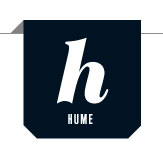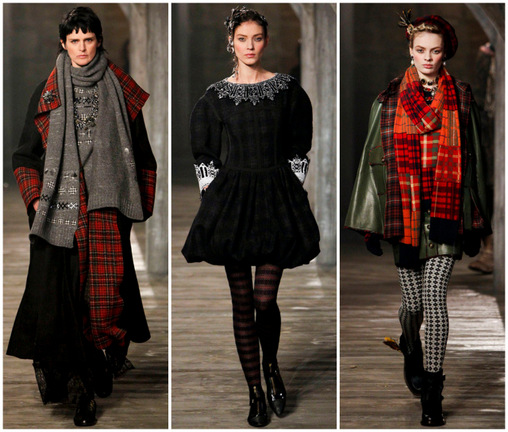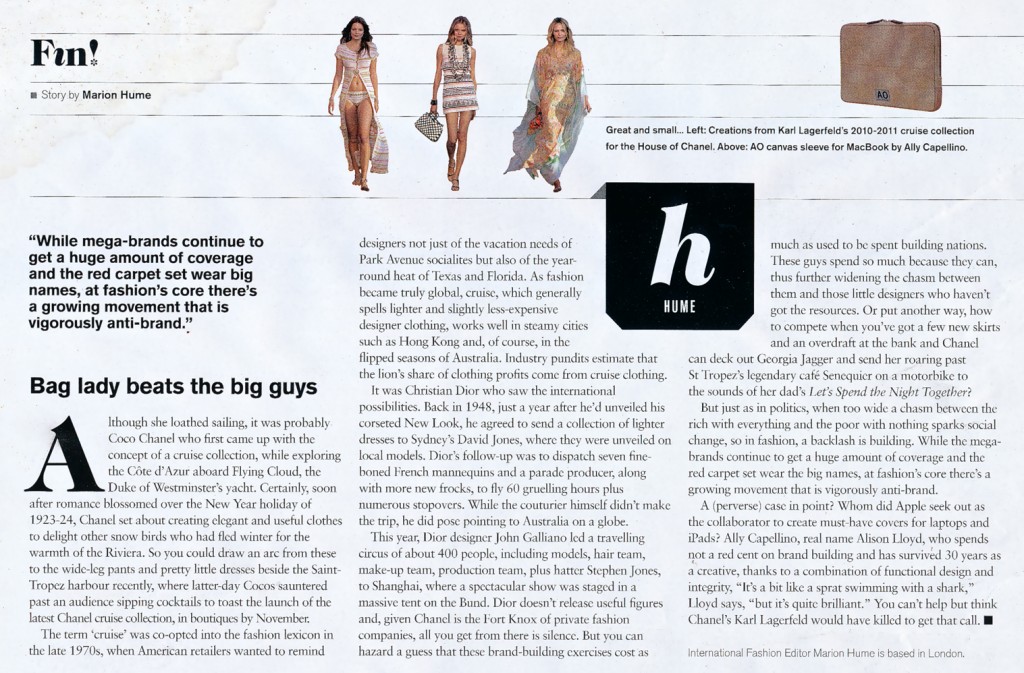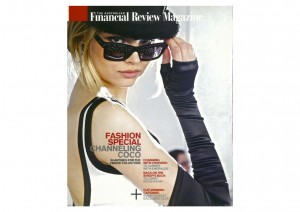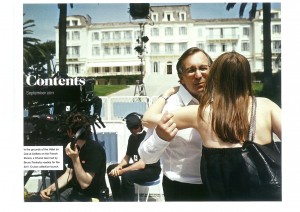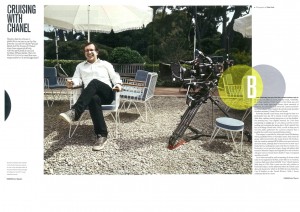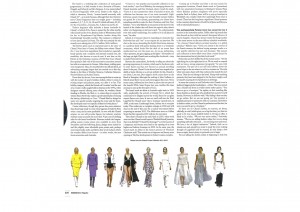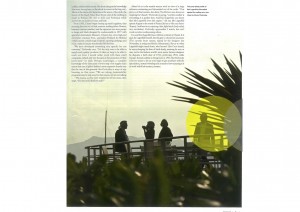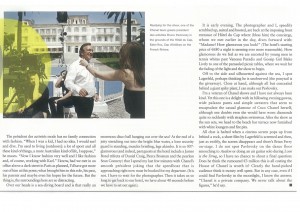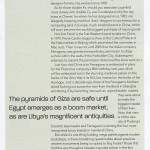AFR | September 2011
Staging fashion shows in glamorous venues is par for the premier course for haute Parisian labels but the house of Chanel does have especial affinity with the perfumed air around Antibes. Where better, than, for Marion Hume to meet the man responsible for its extravaganzas?
Bruno Pavlovsky just may have the coolest business card on the planet. It is white of course, with the words, “CHANEL 2931 Rue Cambon, 75001 Paris”, in inky black sans serif type in the lower right hand corner; those essentials of telephone, fax and email in the lower left. Centered and below his name, is his job title; président des activités mode (president of fashion activities), Chanel. How cool is that?
Pavlovsky himself is easybreezy, even though we meet on a particularly busy day. He is relaxed of style: dark trousers, white shirt, cashmere sweater slung just so over his shoulders. On meeting him, I am slightly stunned, for I had been anticipating an uptight guy in a tie doing a job that involves cajoling and containing the genius that is Karl Lagerfeld (the face of all things Chanel since 1983), as well as being one of very few public spokesmen for a private company that is possibly the world’s most successful fashion empire.
That empire is controlled by Alain and Gerard Wertheimer, whose grandfather Pierre co-founded Chanel. Alain chairs the group, while Gerard chairs the watch division The brothers, who are worth an estimated $US6 billion never give interviews about the brand, although they’ve been known to show up at Chanel shows, sneaking into seats in the third or fourth rows. Pavlovsky is a row one kind of guy. Along with global chief executive Maureen Chiquet and Lagerfeld, he is one of the few who give voice to a brand whose ‘double-C’ logo is recognised anywhere on earth.
As to where on earth he and I are meeting, do let me set that scene. It was supposed to be Paris, at his office in rue Cambon, a narrow, dark street where Gabrielle ‘Coco’ Chanel opened a little shop in 1910. But it turns out the only window in Pavlovsky’s diary is on the afternoon before the Chanel cruise show, the location for which is the Hôtel du Cap, Eden Roc, Cap D’Antibes on the French Riviera. Yeah, I know, sometimes this job is a chore.
The hotel itself is a wedding cake confection of such grand gorgeousness, it is little wonder it was a favourite of Picasso, Chagall and Edward & Mrs Simpson. It was immortalized in F. Scott Fitzgerald’s 1934 novel “Tender is the Night”, in which a character called Nicole, “crosses herself reverently with Chanel sixteen” – an in-joke because, although there have been far more Chanel fragrances than you might guess – incdlung Nos. 1, 2, 7 , 9, 11, 14, both 18 and 19 which still exist, 20, 21, 27, 46, 55 as well as , of course No. 5, there has never been a No.16.
Today’s fragrance offer includes a dozen “exclusifs de Chanel”, of which 28 La Pausa is named for the white marble villa Chanel had her lover, Bendor, Duke of Westminster, build for her at Roquebrune Cap Martin, further along this breathtakingly beautiful coastline. The company is whispered to have just acquired La Pausa. The villa was certainly for sale recently at an asking price of €11.2 million ($14.6 million).
The Riviera plays such an important part in the story of Chanel. Near here is Grasse, the hilltop town where Chanel No. 5 was born from ingredients including an especially heady jasmine and a complex and intensely-scented rose, the centifolia, also known as rose de mai. It was here on the Riviera in the Christmas vacation of 1920, that Coco Chanel first spritzed a little vial of this innovative concoction around her table at a restaurant in Cannes. Other diners, walking past, were enraptured. Thus, five months before its official debut, did an advertising campaign begin that has carried on to this day, thanks to the likes of Marilyn Monroe, Catherine Deneuve, Nicole Kidman and Audrey Tautou.
Down here by the sea, Coco was among the first to come up with the notion of sporty holiday clothes; when it comes to mixing stripes and palazzo pants, our debt is to her. This holiday category, which the French call croisiere and the the rest of us ‘cruise’, really caught hold in America in the 1970s, when designers started offering extra clothes for wealthy clients heading to Florida, the Med or to cruise ships to escape the winter. Bruno Pavlovsky makes a good-natured play for tracing the history, definitively, to Coco. “Chanel liked to design for some very specific people, targeting the cruise and the boats. She developed some very specific clothes for lovely places.”
Cruise collections, though they garner less press attention than those huge ready-to-wear extravaganzas revealed in Paris twice a year, are far more profitable. As ever with the Chanel empire, no one will provide figures, but industry analysts estimate Cruise accounts for more than 70% of clothing sales for the brand worldwide. Reasons include the longest selling season (cruise pieces stay available in store from December until the following June), designs more suited for real life; slightly more affordable price points; and perhaps most importantly, styles and fabrics that work in places where the weather differs from France-in other words, the new boom economies and Australia.
“Cruise is a very popular and successful collection in our local market,” says David Blakeley, the managing director for Chanel Australia and New Zealand, whom I reach by email. “Given it is our summertime when it launches in-store, the collection has become one of our most successful. Light knitwear, casual evening wear and beautiful summer fabrics are geared for a hot climate guaranteeing our clients have something suitable to select for their Christmas and New Year holidays.” As to why Blakeley is not present at the show for the launch of the clothes that will drive his region’s sales, there’s rather a lot happening on his local watch. “So unfortunately, even with today’s technology, I’m unable to be in all places at once,” he jokes.
Indeed, it is because Chanel is expanding in Australia that Bruno Pavlovsky has said “yes” to my request for an interview. We chat on the movie descending the hotel’s blond stone staircase to a pathway lined with palms leading down to a beachside restaurant, which looks like the deck of an ocean liner cantilevered out over the azure sea. As we go, technicians, video operators, the guys rigging up the lights-all members of the large-yet-tight Chanel team working like clockwork-stop to shake Pavlovsky’s hand.
Between the cameraderie, Pavlovsky is telling me about the growing importance of croisiere, which used to be shown only to store buyers and has now become an annual travelling show. In the past, Chanel Cruise shows have been staged as far afield as Santa Monica on a private airfield. (In this Chanel is not alone. Last year, Dior staged a lavish cruise show on the Bund in Shanghai, although the sacking of John Galliano in March meant there was no such extravaganza this year). Yet in recent years, celebrations have been in places that are part of the brand’s DNA; Saint-Tropez last year, Antibes this time around, to sum up the free spirit of Coco.
The brand made its debut in Australia right back in 1922, with, predictably, the arrival of Chanel No.5, which has continued to be shipped across the world, flacon by cut glass square flacon ever since. It was not until well into the “Karl Lagerfeld for Chanel years” that a boutique opened here, in 1989, at the same Castlereagh Street, Sydney, site it occupies today. This underwent a complete redesign in 2000 and will close at the end of this year for a radical renovation before reopening in Autumn 2012. The Melbourne store on Collins Street that first opened in 2001 will also be renovated.
Then there’s Chanel in the mall. Back in 2007, when word went out that Chanel would open in Westfield Bondi Junction, there was disbelief, (“Chanel! In the Junga?”), yet the success of a fragrance and beauty store lead to the opening of an even higher-end fashion boutique in 2009. In the same year, the brand made its debut in the luxury precinct of Victoria’s Chadstone mall. This month sees a fragrance and beauty store opening at The Star development in Sydney’s casino complex.
Coming up in October and after a six-year search for appropriate locations, Chanel heads North to Queensland, with two stand-alone boutiques in Brisbane’s Queens Plaza where Blakeley predicts that sunglasses will prove especially popular. Back in Sydney, there will be a pop-up boutique in Westfield’s City complex while the Castlereagh Street store is closed. (There has also long been a significant Chanel presence in the cosmetics departments of both David Jones and Myer as well as selected pharmacies.
This quintessentially Parisian brand has earned the love it receives in the Australian market. Unlike other big brands that first showed up here with last season’s European leftovers, (it used to happen), Chanel has always treated far-flung loyalists to the same season on the same delivery schedule worldwide. “As a brand, Chanel delivers product launches to a global calendar,” says Blakeley. “Given our climate is the reverse of the French seasons, the Fashion Buying Manager works to a very specific ‘collection buy’ per each boutique. This ensures each collection in store offers every client a varied choice for their international travel, plus their local needs.”
Pavlovsky he says he’s thrilled by all this Aussie action. “It’s the right thing for us, the right time for us. We are ready to expand and we have a strong expansion [program],” he says with excitement. By now, the pair of us are still only half way down the gravel slope to the sea where we sit for a moment on ’50s-style white wire patio chairs with blue cushions that matching the sea’s colour. These do not belong to the hotel. Along with matching parasols, they have been shipped in for the show tonight, such is Chanel’s exacting level of perfection in all things.
It seems the moment to ask Pavlovsky why Chanel is not in fashion’s biggest global marketplace-online. That you cannot buy a Chanel suit from an e-tailer seems rather quaint. “You have to go a boutique,” he replies, at first sounding like those doubters did a decade ago when predicting net-a-porter’s swift demise. However he follows with, “My feeling is that one day we go online. But we are not going yet. Our product is sophisticated and we need to be with our customer. I do believe in fashion online, yes. But Chanel is perfection and for that, for now, you need to go to a boutique”.
So there are no Chanel clothes, no scarves, no shoes, officially, at e-tail (which gives you a big clue that, yes, that too-good-to-be-true classic Chanel padded leather 2.55 bag on e-Bay is likely to be a fake). “We are very active online,” Pavlovsky stresses. “We are not selling fashion online, but we are doing something with [the web] and…we are, at the moment, doing more and more. We have a lot of digital initiatives.” Indeed, click on to chanel.com and should you want to study the every waking thought of Karl Lagerfeld (and be warned, he only sleeps a few hours a night), there’s plenty to persuade you to linger.
Yet not selling the clothes online is beginning to look less luddite, indeed rather smart (like those smug in the knowledge that never having been on Facebook is right in the long run). Much of the charm of Chanel lies in the weave of the cloth, the beauty of the finish. More than 80 % of the clothing is made in France, the rest in Italy and Scotland while accessories are made in France and Italy.
From 1985, Chanel began buying up small suppliers, thus ensured the survival of little maisons making fabric flowers, buttons, costume jewellery and the signature two-tone pumps in beige and black designed by mademoiselle in 1957 with specialist shoemakers Massaro. Chanel also owns the high-end swimwear company Eres, the gunmaker Holland & Holland (which carries a small range of specific sporting clothing); and it has a stake in the luxury watchmaker, Bell & Ross.
“We have developed something very specific for our customer,” says Pavlovsky. “It’s the only way to be able to supply such a quality of products. It takes so long to be able to reach our level. I would rather work with these small companies, [which are] very focused on the protection of their know-how,” he adds. Perhaps surprisingly, a complete knowledge of the intricacies of every step of its supply chain means that one of global fashion’s most expensive brands may thus be one of the greenest. But Pavlovsky is wary of any boasting on that score. “We are taking [sustainability programs] step by step and, for that reason, we are not talking…” He pauses, as if he were tempted to tell me more, then stops. “It is too early. Shall we walk?”
Ahead of us now is the seaside terrace with its view of a huge saltwater swimming pool dynamited out of the rocks. “Our story is of this location, the décor. The Riviera was always so inspiring for Chanel,” Pavlovsky is saying, “and the weather is everything; it is perfect here. And Karl Lagerfeld, you know that Mr Largerfeld loves this region.” Ah yes, Mr. Lagerfeld, who spends August in the South of France [he has a villa near Saint-Tropez]. And here he is, enjoying a light, late lunch (leafy salads, tiny artichokes). Pavlovsky approaches. I watch, but can’t work out who is schmoozing whom.
It is said that Karl Lagerfeld has a lifetime contract at Chanel. It is said, by Lagerfeld himself, that he gets to choose his successor. (The current front runner, tipped by the designer last November, is the rising star Haider Ackermann). But as to when Lagerfeld might stand down, who knows? Like Coco herself, he enjoys keeping his date of birth shady, meaning he may or may not be the fashion world’s most senior world famous designer: he disputes a birth date of 1933, preferring 1938, while Giorgio Armani admits to being born in 1934. But Pavlovsky is far too smart to let me even begin to get anywhere with speculation, instead wheeling talk around to how amazing it is to work with Karl etc., etc.,
The President des Activites Mode has no family connection with fashion. “When I was a kid, I had no idea. I would surf and dive. I’m used to living [outdoors]: a lot of sport and all these kind of things, a more Australian kind of life, I suppose,” he muses. “Now I know fashion very well, and I like fashion and of course working with Karl.” I know, had we met in an office above a dark street in Paris as planned, I’d have got more out of him at this point; what brought him to this role, his past, his parents and maybe even his hopes for the future. But the thing is, the surroundings are so distracting.
Over our heads is a sea-diving board and is that really an enormous disco ball hanging out over the sea? At the end of a jetty stretching out into the bright blue water, a lone security guard is standing muscles bristling, legs akimbo. It is so 007-glamourous (and indeed, past guests at the hotel include a James Bond trifecta of Daniel Craig, Pierce Brosnan and the peerless Sean Connery) that I spend my last few minutes with Chanel’s smooth President joking that the speedboat that is approaching right now must be booked for my departure. (It is not. I have to wait for the photographer. Then it takes us so long to get back to our hotel, we have about 40 seconds before we have to get out again).
It is early evening. The photographer and I, speedily scrubbed up, suited and booted, are back at the imposing front entrance of Hotel du Cap where, (bless him) the concierge who we have met earlier in the day dives forward with “Madame! How glamourous you look!” (The hotel’s starting price of 680 euros a night is seeming ever-more reasonable). How glamourous do we feel as we are escorted by young men in tennis whites, past Vanessa Paradis and Gossip Girl, Blake Lively to one of the parasoled picnic tables, where we wait for the fading of the light and the show to begin.
Off to the side and silhouetted against the sea, I spot Lagerfeld, perhaps thinking he is unobserved (the ponytail is the giveaway). Close at hand, although all but concealed behind a giant spiky plant, I can make out Pavlovsky.
I’m a veteran of Chanel shows and I have not always been kind. Yet this one is a delight with its billowing evening gowns, wide palazzo pants and simple sweaters which seem to encapsulate the casual glamour of Coco Chanel herself, although one doubts even she would have worn diamonds so recklessly with strapless swimwear. After the show, as the sun sets, we head to the beach bar terrace now furnished with white loungers and fire pits.
All chat is praise halted when a cinema screen pops up from behind a rock, a short film by Lagerfeld is screened and then, just as swiftly, the screen disappears and there’s Brian Ferry on stage. I do not spot Pavlovsky on the dance floor smooching to Avalon or doing an air guitar solo during Love is the Drug so I have no chance to shout a final question; whether he thinks the rumoured €3 million this is all costing the House of Chanel is worth it. Clearly the hand-picked audience think it money well spent. But in any case, even if I could find Pavlovsky in the moonlight, I know the answer “Chanel is a private company. We never talk about the figures,” he’d say.

